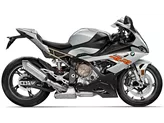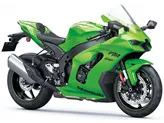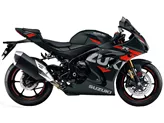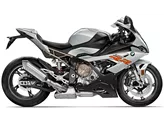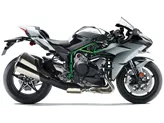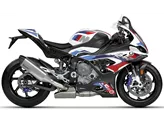BMW S 1000 RR 2017 vs. Suzuki GSX-R 1000 2015

BMW S 1000 RR 2017

Suzuki GSX-R 1000 2015
Overview - BMW S 1000 RR 2017 vs Suzuki GSX-R 1000 2015
The BMW S 1000 RR model year 2017 and the Suzuki GSX-R 1000 model year 2015 are both supersport motorcycles with similar engine types, displacements, and cylinder configurations. However, there are several notable differences between the two models.
In terms of engine specifications, the BMW S 1000 RR 2017 has a larger bore (80 mm) and a shorter stroke (49.7 mm) compared to the Suzuki GSX-R 1000 2015, which has a smaller bore (74.5 mm) and a longer stroke (57.3 mm). This results in the BMW having a higher engine power of 199 HP compared to the Suzuki's 185 HP. The BMW also has a higher torque of 113 Nm compared to the Suzuki's 116.7 Nm. Additionally, the BMW has a higher compression ratio of 13 compared to the Suzuki's 12.8.
Both motorcycles feature an aluminum frame, but the BMW S 1000 RR 2017 has a twin tube frame while the Suzuki GSX-R 1000 2015 has a twin-spar frame. The choice of frame design can affect the handling and stability of the motorcycle.

BMW S 1000 RR 2017
In terms of braking technology, both motorcycles feature double disk brakes with radial technology at the front. This allows for better braking performance and control.
In terms of dimensions and weights, both motorcycles have the same front and rear tire widths and diameters. However, the BMW S 1000 RR 2017 has a slightly longer wheelbase of 1438 mm compared to the Suzuki's 1405 mm. The seat height of the BMW is also slightly higher at 815 mm compared to the Suzuki's 810 mm. The BMW is slightly heavier with a kerb weight of 208 kg compared to the Suzuki's 205 kg. Both motorcycles have the same fuel tank capacity of 17.5 liters.
Now, let's discuss the strengths and weaknesses of each motorcycle. The BMW S 1000 RR 2017 has several strengths. It is available with complete electronic equipment, offering advanced features and high-quality components. The engine is powerful and easy to control, providing strong performance. The seating position is comfortable, even for taller riders. The chassis performs well both on the road and at trackdays.
On the other hand, the BMW S 1000 RR 2017 has a few weaknesses. Some riders have reported brake fade on the racetrack under high load, which can be a concern for aggressive riding. While the ride quality is good enough for trackdays, it may not be suitable for racing. Additionally, some riders find the design of the BMW to be a bit dull, despite its up-to-date technology.

Suzuki GSX-R 1000 2015
The Suzuki GSX-R 1000 2015 also has its strengths. It is known for its sophisticated technology and benefits from the wealth of experience gained from years of successful racing. The model also offers a wide range of accessories, allowing riders to customize and enhance their motorcycle.
However, the Suzuki GSX-R 1000 2015 has a couple of weaknesses. Like the BMW, the design of the Suzuki may appear outdated to some riders. Additionally, the electronics on the Suzuki may not be as up to date as those on the BMW.
In conclusion, the BMW S 1000 RR 2017 and the Suzuki GSX-R 1000 2015 are both powerful supersport motorcycles with their own strengths and weaknesses. The BMW offers a complete electronic package, strong engine performance, and a comfortable seating position. The Suzuki, on the other hand, benefits from years of racing experience and offers a wide range of accessories. Ultimately, the choice between the two models will depend on the rider's preferences and priorities.
Technical Specifications BMW S 1000 RR 2017 compared to Suzuki GSX-R 1000 2015
Pros and Cons in comparison
Pros and Cons in comparison
BMW S 1000 RR 2017

Ce talent universel et équilibré restera en tête de nombreux tests comparatifs en 2017. Elle marque toujours des points grâce à son moteur exceptionnel et à ses caractéristiques universelles et complètes.
Suzuki GSX-R 1000 2015

De nombreuses années de victoires dans la compétition moto internationale ont fait de la Superbike GSX-R1000 une légende - et un modèle un peu grisonnant. En effet, les véritables innovations, voire les révolutions, remontent à une éternité, les dernières mises à jour se limitant à des améliorations esthétiques, comme récemment avec la peinture MotoGP Replica. La GSX-R a certes l'air fraîche et rapide, mais dans le segment des hypersportives technologiquement très développées et donc très chères, elle ressemble à un modèle originel légèrement grisonnant. Elle se conduit toujours bien, rapidement et harmonieusement, on remarque simplement sa maturité - et c'est positif. Nous attendons néanmoins déjà la prochaine génération.
Price Comparison Avarage Market Price BMW S 1000 RR vs Suzuki GSX-R 1000
There are a few key differences between a BMW S 1000 RR 2017 and a Suzuki GSX-R 1000 2015. There are the same number of bikes of both models available on the 1000PS.de marketplace, specifically 9. It takes less time to sell a Suzuki GSX-R 1000 with 83 days compared to 96 days for the BMW S 1000 RR. Since model year 2010 1000PS.de editors have written 135 reviews for the BMW S 1000 RR and 71 reviews for the Suzuki GSX-R 1000 since model year 2005. The first review for the BMW S 1000 RR was published on 4/16/2008 and now has more than 4,000 views. This compares to more than 7,100 views for the first review on Suzuki GSX-R 1000 published on 3/3/2004.



